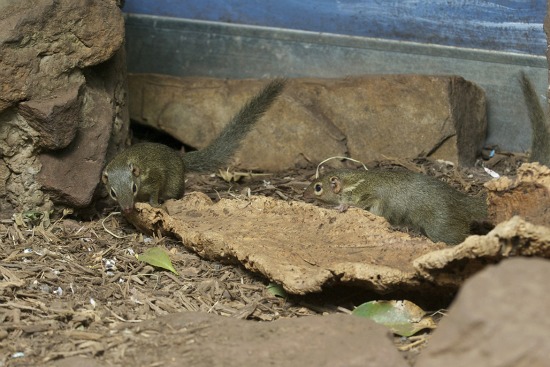Zoo Celebrates Birth of Baby Tree Shrews
A pair of tiny mammals emerge from their nest fully grown at the Zoo
/https://tf-cmsv2-smithsonianmag-media.s3.amazonaws.com/filer/20111007100004tree-shrew-1-small.jpg)
In August, at the National Zoo, the efforts of keepers and biologists finally came to fruition as two baby tree shrews were born. But because of the secretive rearing habits of the species, zoo staff had no way of knowing until nearly two months later, when the shrews were fully grown.
“One of the many things that’s interesting about them is the way they’re cared for as young,” says David Kessler, a biologist at the Zoo. “What happens is, as soon as they’re born, they’ll nurse, and they will drink up to 50 percent of their body weight in one nursing. Then they’re in a nest, and the female has her own nest separate from where they are, and she’ll only come and nurse the young once every 48 hours.”
This lack of contact means that the tiny babies—each one just six to ten grams in weight—are effectively hidden for their entire maturation period.
When the offspring finally emerged almost fully grown last week, Zoo staff learned that the plan put in place last spring as part of a nationwide population management plan was a success. “We have been very successful in the past breeding them, so it was recommended that we swap one of our castrated males for an intact male,” Kessler says. “The population in zoos all around North America is now 47, after the birth of these two.”
The National Zoo is now home to six of these fascinating small creatures. Despite their name, they are not true shrews, and are no longer classified as insectivores, but rather in their own order Scandentia. Native to southeast Asia and China, they can live in both tropical and temperate forests, at elevations up to about 10,000 feet.
“Even though they’re called tree shrews, not all of them live up in the trees all the time,” says Kessler. “They’ll eat fruits, vegetables and insect material. Here at the Zoo we feed them crickets, meal worms, wax worms, fruits and vegetables.”
Perhaps the strangest facet of tree shrew life is the symbiotic relationship they share with carnivorous pitcher plants in the wild. “They defecate in the pitcher plants—they use them like little toilets,” Kessler says. “The shrews get some food from being around the pitcher plants, and the feces of the tree shrew account for 57 to 100 percent of the plants’ nitrogen intake.”
The rapid maturation of the Zoo’s tree shrew babies is now nearly complete. “Their ears are open around ten days, their eyes at 20,” says Kessler. “They come out of the nest at around four weeks or so, and then they’re sexually mature within two to three months.”
Kessler reports that Zoo visitors can come see the shrew offspring, which are becoming more active each day. “They are on exhibit, and can be seen at the Small Mammal House,” he says. “They still do not emerge from the nest that much yet, but they’ll be out more and more frequently as the days go on.”
/https://tf-cmsv2-smithsonianmag-media.s3.amazonaws.com/accounts/headshot/joseph-stromberg-240.jpg)

/https://tf-cmsv2-smithsonianmag-media.s3.amazonaws.com/accounts/headshot/joseph-stromberg-240.jpg)